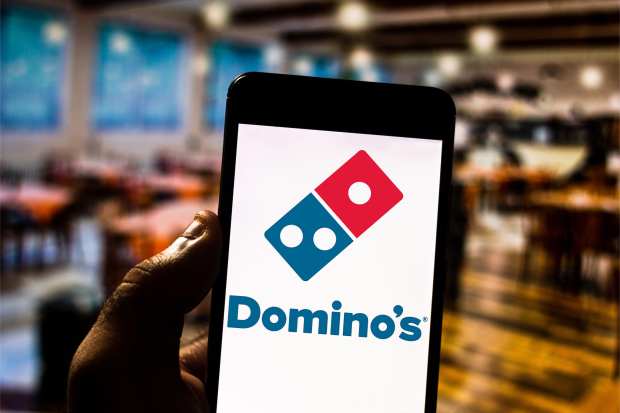What Domino’s Mobile Slice Says About The New QSR World

It’s been quite a ride for Domino’s over the last decade or so. The pizza chain has transformed itself from a spot for late-night food requests from dorm-room residents — to a leader in mobile and digital technologies, and a blazer of its own path in the quick-service restaurant (QSR) world.
And that story, freshly documented by new PYMNTS research, offers lessons for the industry at large as this new decade gets underway. The recently released Mobile Order-Ahead Tracker, a Kount and PYMNTS collaboration, digs deep into how the consumer experience and consumer engagement are guiding the pizza chain’s newest efforts to innovate in the QSR space. The report emerges at time of greater focus on the pros and cons of the third-party delivery aggregator ecosystem — Domino’s has gone its own way and controls its own delivery operations — and the ongoing rise of mobile order-ahead technology.
Less Than Full Potential
First, a few broad points — data that helps define the context in which Domino’s is operating and innovating. As popular as mobile order-ahead programs have become, they are still not being used to their full potential, at least according to that PYMNTS research report. For instance, consider the various tools and offerings that come via mobile order-ahead and mother mobile-focused QSR programs — and the fact that consumers are not using them at anything resembling full speed, at least not yet. Some 42 percent of consumers use their mobile devices to look for coupons and deals, while 38 percent use those devices to peruse menu items and 37 percent use them to search for nearby QSR locations. Clearly, there is room for growth, innovation and even more disruption when it comes to mobile technology and QSRs.
That point becomes even more clear when one realizes that while about 33 percent of respondents in the PYMNTS tracker said they use mobile ordering more often than was the case two years ago — that’s a meaty growth trend — the placing of and paying for orders each accounted for less than a third of all those smartphone-tethered restaurant interactions. What’s standing in the way of further growth? Worries about fraud are a big factor, according to PYMNTS research.
Domino’s, of course, is as aware of those concerns as any other QSR operator, given that the chain was a pioneer in online and mobile ordering and delivery tools, with a solid history that goes back a good 10 years. How much has Domino’s changed since then? Well, taking this into account: Former CEO Patrick Doyle once famously claimed that Domino’s was a technology company that happened to sell pizzas. One can hear shades of Amazon and Uber in such a statement.
Domino’s anchored its mobile and mobile order-ahead efforts in figuring out what its customers really wanted — a lesson that seems obvious but is easier said than done, especially in the technological land rush that is the QSR world of the 2020s.
Indeed, as Domino’s Vice President of Global eCommerce and Digital Marketing Christopher Thomas-Moore told PYMNTS, anticipating and responding to customer demands has driven Domino’s mobile ordering initiatives since the company’s onset. And listening well to those demands is how the chain continues to learn from both customers and competitors as it forges ahead in the digital ordering space. Peers and competitors of Domino’s would do well to heed those statements, as the increasing treasure trove of consumer data being collected via mobile and online channels is nothing without wise analysis and analysis-based determinations — no matter whether that comes from machine learning or artificial intelligence (AI) algorithms, as will increasingly be the case for QSRs over the next few years.
Beyond Algorithms
That future will involve much more than sophisticated mathematical formulas, of course. As PYMNTS has regularly documented — and as Thomas-Moore confirmed during his interview — the so-called connected or “smart” home is taking on more commerce and payment responsibilities. Consumers are acquiring and using more connected devices, including during their daily routines, and are often staying home more often, given the streaming and other entertainment options available to them. And voice-assisted retail devices are helping to power that trend, which in turn makes it easy to order a quick dinner — or a few pizzas — for the family at the end of a hectic day.
In fact, hungry consumers can now order Domino’s food via Amazon’s Alexa, Google Home, smartwatches and a host of other products and services. That’s hardly the full story, either. Social networks such as Twitter now feature Domino’s ordering capabilities, allowing hungry users to simply tweet a pizza emoji to reorder food and pay with saved transaction information. “That’s the one I actually hear most about when I’m traveling and talking to people about what I do,” Thomas-Moore told PYMNTS.
Domino’s was also one of the first players in voice-activated mobile ordering. Its AI-enabled chatbot, Dom, launched as voice-activated app in 2014, enabling customers to place orders just like they would with a live operator. The bot has since driven more than half a million orders, according to Thomas-Moore, and its popularity continues to increase.
For those of us relatively older folks who have fond memories of those hot Domino’s pizzas arriving in the dorm lobby at 1 a.m., it can still feel odd to now view Domino’s as a trailblazer of online and mobile commerce. But as the PYMNTS research shows, pizza is opening the door to a host of new realities for the QSR world in 2020.
